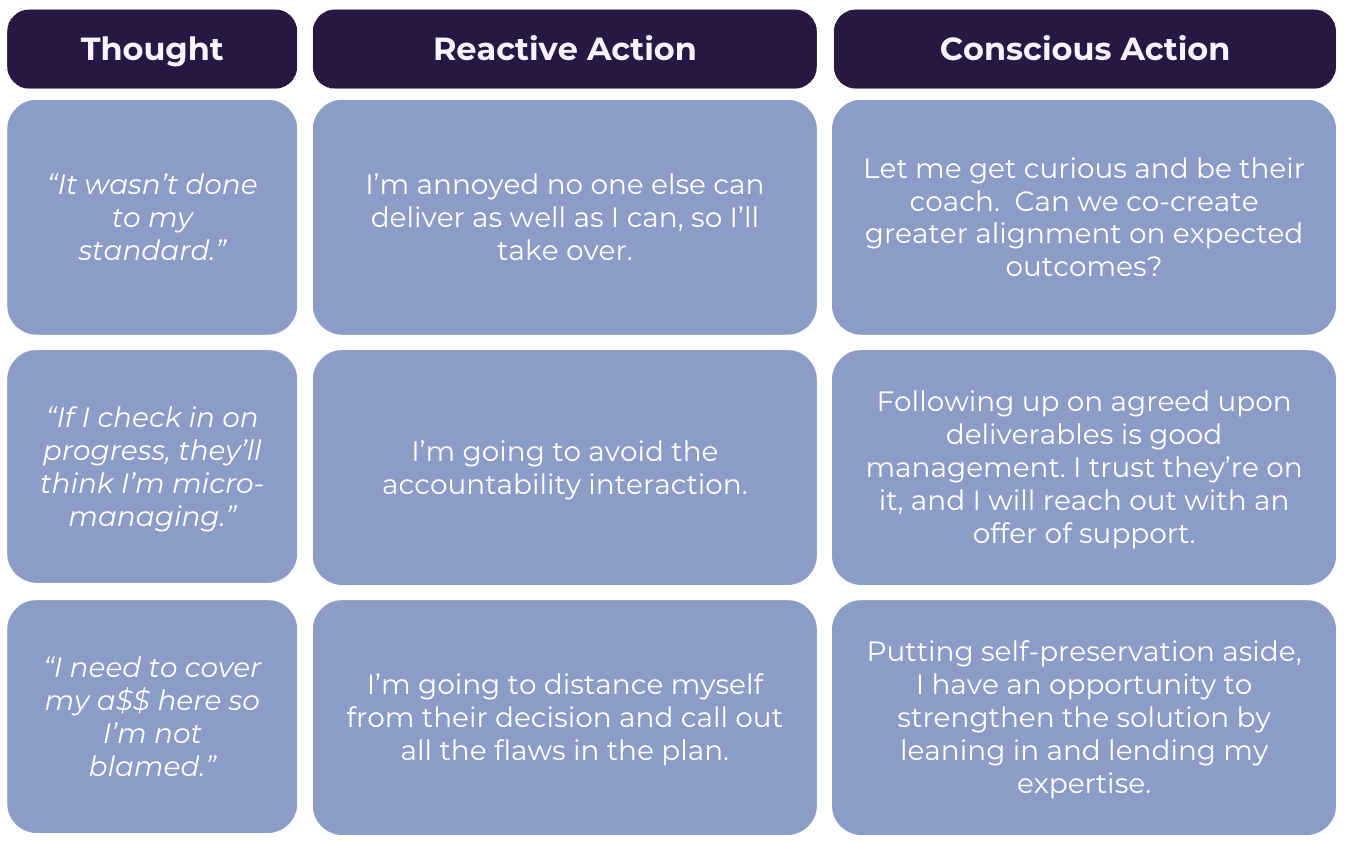Why You Keep Jumping In, Playing Nice, or Holding Back
A practical guide to recognizing and rewiring unhelpful leadership patterns.
Your inner thoughts, assumptions, and narratives drive your leadership action (or inaction).
In other words:
Your inner game drives your outer game.
If you want to be a more effective leader, it starts with examining your internal operating system.
Today I invite you to challenge your inner narratives and explore the extent to which they are working for, or against, you and your desired impact.
Let’s dive in…here’s our roadmap:
3 Common Tendencies
When Strengths Become Liabilities
Learning To Recognize Your Patterns
3 Common Tendencies
Let me introduce you to 3 Tendencies that the wise folks behind The Leadership Circle Profile have identified through the study of more than 4 million leadership assessments.
These are called Tendencies because they’re reactive thoughts and assumptions.
Some of these can be considered strengths in some situations, and when they are misused, or overused, these thought patterns become liabilities.
Read through the following brief, high-level descriptions. Notice which elements speak to you most:
Complying
You’re aware of others and have great empathy and human understanding. Much of your self-worth comes from what others think of you. You comply with expectations of others, can act conservatively so as not to rock the boat, desire to please and belong with those you engage with most.
You likely say Yes when you wish to say No. And you might find yourself giving away your own agency and power to others and circumstances.
Controlling
You have standards and a solid work ethic. You derive a good piece of your identity from your work and what you've accomplished.
Perfectionism can be something you relate with and struggle to overcome. You like things done a certain way and have been known to jump in and take over when things aren’t going as planned.
Protecting
You’re able to objectively approach challenging situations with minimal emotion. You’re praised for your intellect, creating a thought pattern of “I am my ideas, I am the smart strategies I bring to the table.”
And when things are challenging you can distance yourself, causing others to perceive you as aloof and an emotionally distant leader. You can be critical of others, their ideas, and navigate situations with a cynical orientation.
2 questions to challenge you:
Which elements felt like they came directly from your own brain?
In what ways do you notice these thoughts impact your actions?
I ask for this simple reason:
“Leadership effectiveness improves as consciousness evolves.”
- Mastering Leadership, Anderson & Adams
Awareness of our inner narratives, the stories we’ve likely spent our whole lives telling ourselves, is our first key to becoming a stronger leader.
When Strengths Become Liabilities
Growing up, I was always praised for being the good student and the high achiever.
Achieving was a strength of mine. Until I became a people manager.
I like things done a certain way (ask my husband about how I like the dishwasher loaded). I find it easier to jump in and fix something than take the time to share my thinking with others.
I soon realized my strengths were turning into liabilities.
When I jumped in, I was hindering collaboration and mentorship. When I dictated how to get something done, I was limiting my team’s ability to get creative and take ownership.
My tendency is to be high in Controlling.
Maybe you can relate?
Or, perhaps Complying speaks more to you.
Here’s an illustration of how too much Complying shifts from being a strength to becoming a leadership liability:
Learning To Recognize Your Patterns
Our goal isn’t to stop our inner thoughts, it’s to pivot the actions they create.
We want to move from our thoughts creating a reactive action, to enabling a conscious, effective action.
Consider these examples:
Let me offer 3 Pro Tips to get you started…
Pro Tip #1: Identify Your Triggers
Reflect on the situations and conditions that generate these Complying, Controlling, or Protecting thoughts.
What activates your people pleasing tendencies?
When do you feel yourself slipping into self-preservation?
What conditions create a sense that you need to be in control?
Pro Tip #2: Map Out Actions
Similar to the table above, can you map your thoughts to your reactive actions? And then identify the actions you know have greater impact?
Start to see the Reactive vs Conscious so you’re better able to take the Conscious action when the time comes.
Pro Tip #3: Ask for Targeted Feedback & Support
Get help from those around you by asking for targeted feedback and then support.
To someone reporting to you, it might sound like this:
“I’d love to ask for your help with something. One thing I’m working on as a leader is empowering you all more. I notice I can have a tendency to jump in, sometimes limiting how you all are thinking or approaching something. I want to consciously do that less. Can I periodically check in with you to gauge how I’m doing fighting this default tendency of mine?”
Then you might go to your leader with a request for support and accountability. It might sound like this:
“One thing I’m working on with my team is fighting my urge to jump in and solve things for them. It’s not sustainable for me to do that and it ultimately will hinder the broader team’s ability to perform.
And I’ve identified a way you can help hold me accountable. In our 1:1s, as we chat through challenges, if you notice I’m leaning too much into jumping in and solving it for them vs actively helping to coach and develop them to solve it, can you check me in the conversation? It’s a new muscle I’m strengthening and having your second set of eyes would be really helpful.”
Summary
To lead more effectively, start by examining your internal operating system—the beliefs, assumptions, and narratives that shape your behavior. By recognizing your default tendencies (Complying, Controlling, or Protecting), you can shift from reactive patterns to conscious, impactful leadership. Awareness is the first step; intentional practice is what drives lasting change.
As always, be human and have high standards.
- Katie
I’m Katie!
I help leaders drive stronger business results through group training & coaching
I'm also a mom, triathlete, & cowgirl who loves country music and good martinis.
Work with Me
If you’re looking for 2025 to be your break out year as a manager and leader, I’d be honored if you considered adding me into your career development equation.
Live Group Trainings - perfect for managers looking to increase confidence & competence.
1:1 Leadership Coaching - dial into your leadership competencies & tendencies and gain an effective sounding board and action oriented partner.
Accelerate Your Team’s Performance - leverage data & coaching to align and then accelerate how your team works together and how they deliver results.







